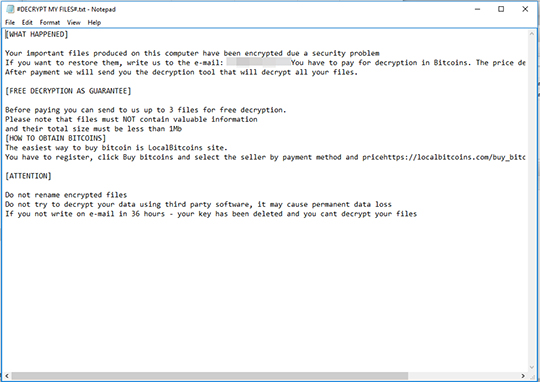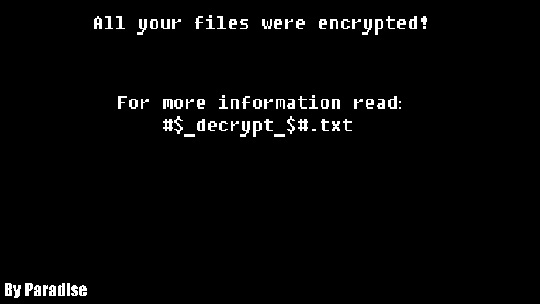RANSOM_PARADISE.A
MSIL/Filecoder.Paradise.A trojan (NOD32)
Windows


Threat Type: Ransomware
Destructiveness: No
Encrypted: No
In the wild: Yes
OVERVIEW
Dropped by other malware, Downloaded from the Internet
This Ransomware arrives on a system as a file dropped by other malware or as a file downloaded unknowingly by users when visiting malicious sites.
It encrypts files found in specific folders. It drops files as ransom note.
TECHNICAL DETAILS
264,192 bytes
EXE
No
12 Jun 2017
Connects to URLs/IPs, Displays graphics/image, Displays message/message boxes, Encrypts files
Arrival Details
This Ransomware arrives on a system as a file dropped by other malware or as a file downloaded unknowingly by users when visiting malicious sites.
Autostart Technique
This Ransomware adds the following registry entries to enable its automatic execution at every system startup:
HKEY_CURRENT_USER\Software\Microsoft\
Windows\CurrentVersion\Run
svch = {malware path}
Other System Modifications
This Ransomware adds the following registry keys:
HKEY_LOCAL_MACHINE\SOFTWARE\Microsoft\
Tracing\{ransom filename}_RASAPI32
HKEY_LOCAL_MACHINE\SOFTWARE\Microsoft\
Tracing\{ransom filename}_ RASMANCS
It changes the desktop wallpaper by modifying the following registry entries:
HKEY_CURRENT_USER\Control Panel\Desktop
WallpaperStyle = "2"
HKEY_CURRENT_USER\Control Panel\Desktop
Tile = "0"
HKEY_CURRENT_USER\Control Panel\Desktop
Wallpaper = "%User Temp%\desk.bmp"
Dropping Routine
This Ransomware drops the following files:
- %Desktop%\Files.txt
- %Desktop%\Failed.txt
- %Desktop%\DecriptionInfo.auth
- %User Temp%\desk.bmp
(Note: %Desktop% is the desktop folder, where it usually is C:\Documents and Settings\{user name}\Desktop in Windows 2000, Windows Server 2003, and Windows XP (32- and 64-bit); C:\Users\{user name}\Desktop in Windows Vista (32- and 64-bit), Windows 7 (32- and 64-bit), Windows 8 (32- and 64-bit), Windows 8.1 (32- and 64-bit), Windows Server 2008, and Windows Server 2012.. %User Temp% is the user's temporary folder, where it usually is C:\Documents and Settings\{user name}\Local Settings\Temp on Windows 2000, Windows Server 2003, and Windows XP (32- and 64-bit); C:\Users\{user name}\AppData\Local\Temp on Windows Vista (32- and 64-bit), Windows 7 (32- and 64-bit), Windows 8 (32- and 64-bit), Windows 8.1 (32- and 64-bit), Windows Server 2008, and Windows Server 2012.)
Ransomware Routine
This Ransomware encrypts files found in the following folders:
- {Drive Letter}:\
- %Desktop%
(Note: %Desktop% is the desktop folder, where it usually is C:\Documents and Settings\{user name}\Desktop in Windows 2000, Windows Server 2003, and Windows XP (32- and 64-bit); C:\Users\{user name}\Desktop in Windows Vista (32- and 64-bit), Windows 7 (32- and 64-bit), Windows 8 (32- and 64-bit), Windows 8.1 (32- and 64-bit), Windows Server 2008, and Windows Server 2012.)
It appends the following extension to the file name of the encrypted files:
- id-3VwVCmhU.[info@{BLOCKED}t.ws].paradise
It drops the following file(s) as ransom note:
- {folder of encrypted files}\#DECRYPT MY FILES#.txt

NOTES:
This ransomware connects to the following URL:
- http://{BLOCKED}.{BLOCKED}.77.47/api/Encrypted.php
It also sends the following information:
- encryption ID
- encrypted file count
- computer name
- elapsed time of encryption
- Decryptioninfo.auth
%User Temp%\desk.bmp looks like:
SOLUTION
9.850
13.654.03
12 Sep 2017
13.655.00
13 Sep 2017
Step 1
Before doing any scans, Windows XP, Windows Vista, and Windows 7 users must disable System Restore to allow full scanning of their computers.
Step 2
Note that not all files, folders, and registry keys and entries are installed on your computer during this malware's/spyware's/grayware's execution. This may be due to incomplete installation or other operating system conditions. If you do not find the same files/folders/registry information, please proceed to the next step.
Step 3
Delete this registry value
Important: Editing the Windows Registry incorrectly can lead to irreversible system malfunction. Please do this step only if you know how or you can ask assistance from your system administrator. Else, check this Microsoft article first before modifying your computer's registry.
- In HKEY_CURRENT_USER\Software\Microsoft\Windows\CurrentVersion\Run
- svch = {malware path}
- svch = {malware path}
Step 4
Delete this registry key
Important: Editing the Windows Registry incorrectly can lead to irreversible system malfunction. Please do this step only if you know how or you can ask assistance from your system administrator. Else, check this Microsoft article first before modifying your computer's registry.
- HKEY_LOCAL_MACHINE\SOFTWARE\Microsoft\Tracing\{ransom filename}_RASAPI32
- HKEY_LOCAL_MACHINE\SOFTWARE\Microsoft\Tracing\{ransom filename}_RASMANCS
Step 5
Search and delete this file
- %Desktop%\Files.txt
- %Desktop%\Failed.txt
- %Desktop%\DecriptionInfo.auth
- {folder of encrypted files}\#DECRYPT MY FILES#.txt
- %User Temp%\desk.bmp
Step 6
Scan your computer with your Trend Micro product to delete files detected as RANSOM_PARADISE.A. If the detected files have already been cleaned, deleted, or quarantined by your Trend Micro product, no further step is required. You may opt to simply delete the quarantined files. Please check this Knowledge Base page for more information.
Step 7
Reset your Desktop properties
Step 8
Restore encrypted files from backup.
Did this description help? Tell us how we did.

